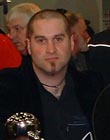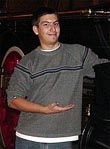|
|
This topic comprises 2 pages: 1 2
|
|
Author
|
Topic: CP55 Static
|
|
|
|
|
|
|
Monte L Fullmer
Film God

Posts: 8367
From: Nampa, Idaho, USA
Registered: Nov 2004
|
 posted 02-05-2005 03:34 AM
posted 02-05-2005 03:34 AM




quote: Cam Jones
guess tomorrow we can try to switch the cards from another processor to see if one of them is the problem.
True, that'd be your first step - "condemning" each card to see if one could be doing this static. And, while you're pulling cards, take a pencil eraser and scrub the gold contacts on the card(s), for hidden corrosion can cause irratic contact between the cards and the sockets. This is a common thing with Dolby products, and even with Ultra-Stereo units with their cards as well.
Then, if the static is still present, check the 'momboard' for any defects as well, for 'momboards' will develop hairline cracks and will have to be replaced.
Also, this static could be caused by a power supply that is getting "tired" thus not getting enough "juice" to the system. Swap out power supplies in the process.
CP55 units are at least 12 yrs old, and those power supplies do get tired after awhile. Dolby still has those CP55 power supplies in stock.
-Monte
| IP: Logged
|
|
|
|
|
|
|
|
|
|
|
|
|
|
|
|
|
|
|
|
|
|
Pete Naples
Phenomenal Film Handler

Posts: 1565
From: Dunfermline, Scotland
Registered: Feb 2001
|
 posted 02-06-2005 07:03 AM
posted 02-06-2005 07:03 AM




Michael, for some reason static seems to prefer a sharp pointed ground rather than a nice smooth sound drum! I've seen the static problem described above many times, especially when polyester film base first appeared, before we learned about it's sensitivity to booth humidity. What I do when hit with this issue is to paint the cell bracket and the cell block (taking it as close to the tip as I dare without getting it on the cell surface) with conductive paint, taking it right back to the screws holding the bracket onto the rep set, having cleaned them with emery paper or a fibre glass pencil first. You still get the static discharge, but with the paint in place it goes to ground via the paint and not through the processor circuitry. The 'frying eggs' noise is more pronounced in theatres using Jax Lights (stands to reason, the pre-amp boosts all signals from the cell, including the unwanted).
Have any of you guys ever examined the surface of a cell that's been hit with this type of static for an extended period under a microscope? It looks like the surface of the moon, covered in pits and craters where the sparks have landed. More than once I've replaced cells damaged in this way, whilst there was no measureable difference, there is a definite audible improvement.
| IP: Logged
|
|
|
|
All times are Central (GMT -6:00)
|
This topic comprises 2 pages: 1 2
|
Powered by Infopop Corporation
UBB.classicTM
6.3.1.2
The Film-Tech Forums are designed for various members related to the cinema industry to express their opinions, viewpoints and testimonials on various products, services and events based upon speculation, personal knowledge and factual information through use, therefore all views represented here allow no liability upon the publishers of this web site and the owners of said views assume no liability for any ill will resulting from these postings. The posts made here are for educational as well as entertainment purposes and as such anyone viewing this portion of the website must accept these views as statements of the author of that opinion
and agrees to release the authors from any and all liability.
|

 Home
Home
 Products
Products
 Store
Store
 Forum
Forum
 Warehouse
Warehouse
 Contact Us
Contact Us




 Printer-friendly view of this topic
Printer-friendly view of this topic















